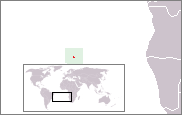Saint Helena hoopoe
| Saint Helena hoopoe | |
|---|---|
| | |
| Scientific classification | |
| Kingdom: | Animalia |
| Phylum: | Chordata |
| Class: | Aves |
| Order: | Coraciiformes |
| Family: | Upupidae |
| Genus: | Upupa |
| Species: | U. antaios |
| Binomial name | |
| Upupa antaios (Olson, 1975) | |
 | |
| Location of Saint Helena | |
| Synonyms | |
|
Upupa antaois (lapsus) | |
The Saint Helena hoopoe (Upupa antaios), also known as the Saint Helena giant hoopoe or giant hoopoe, is an extinct species of the hoopoe (family Upupidae), known exclusively from an incomplete subfossil skeleton.
It was endemic to the island of Saint Helena in the South Atlantic. It was much larger than its European and African relatives, and was completely flightless. The first analysis of this species was given in 1963 by the British zoologist Philip Ashmole, who discovered in the Dry Gut sediments in the east of Saint Helena a left humerus which differed significantly from that of other Upupidae.
The incomplete skeleton, which was found in 1975 by the palaeontologist Storrs L. Olson, consists of both coracoids and the left femur. It is presumed to have become extinct soon after Saint Helena was discovered and colonized in 1502, due to a combination of habitat destruction and the introduction of predators such as black rats, and domestic cats.
As all known hoopoes are insectivores that feed primarily on large insects, the giant hoopoe may have been a predator of the Saint Helena giant earwig (Labidura herculeana), an insect which has not been seen alive since 1967 and is now also extinct.
References
- ↑ BirdLife International (2012). "Upupa antaios". IUCN Red List of Threatened Species. Version 2013.2. International Union for Conservation of Nature. Retrieved 26 November 2013.
- Storrs L. Olson. (1975). Paleornithology of St Helena Island, south Atlantic Ocean. Smithsonian Contributions to Paleobiology 23.
